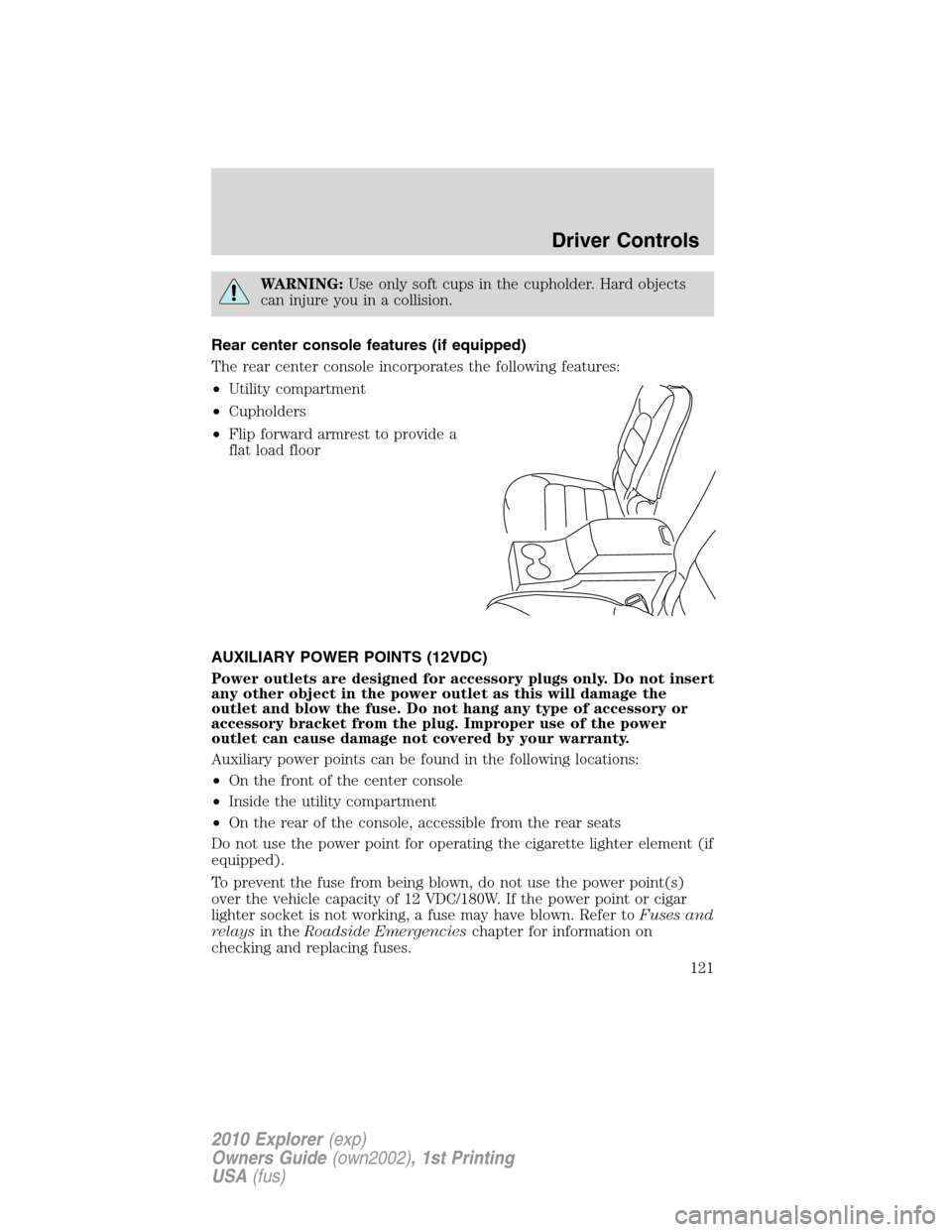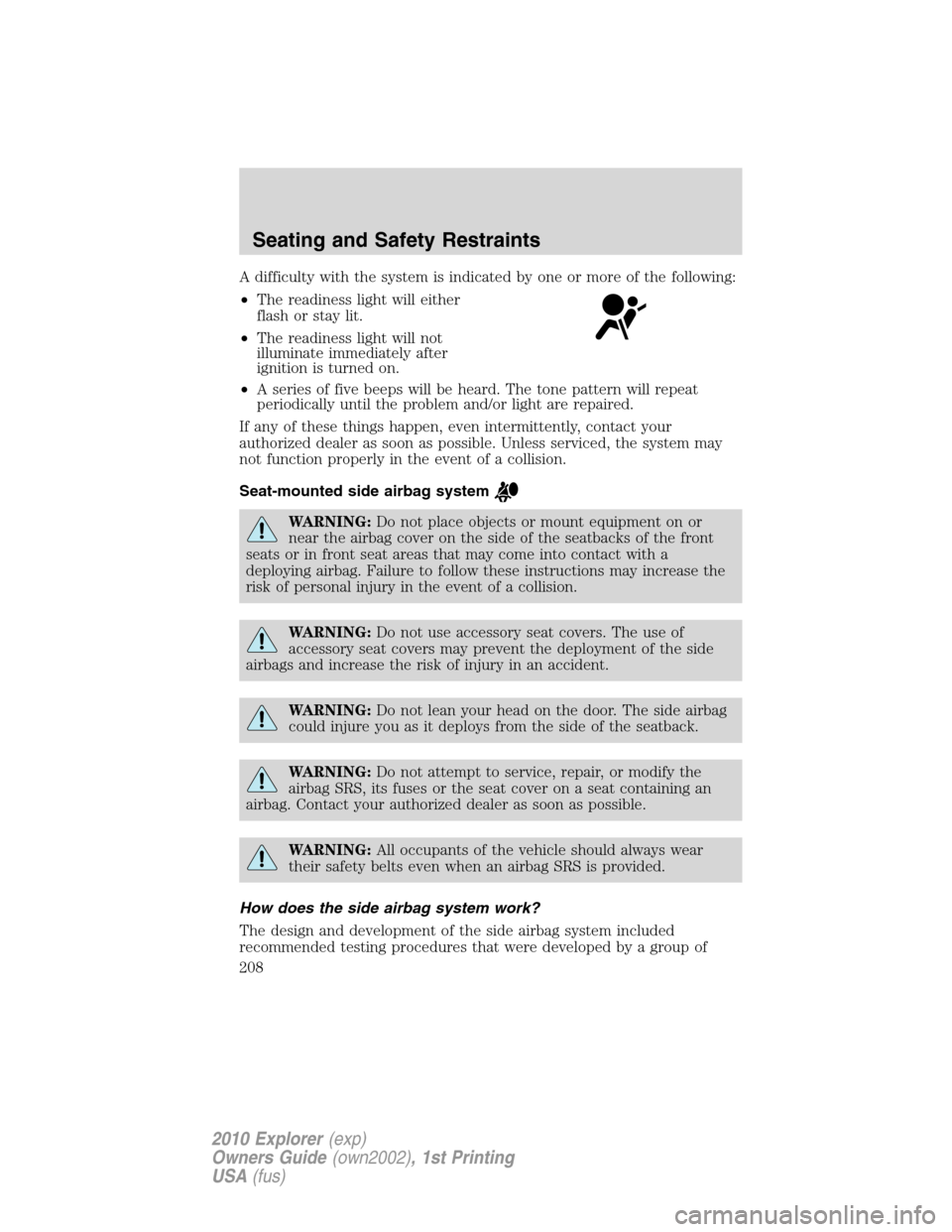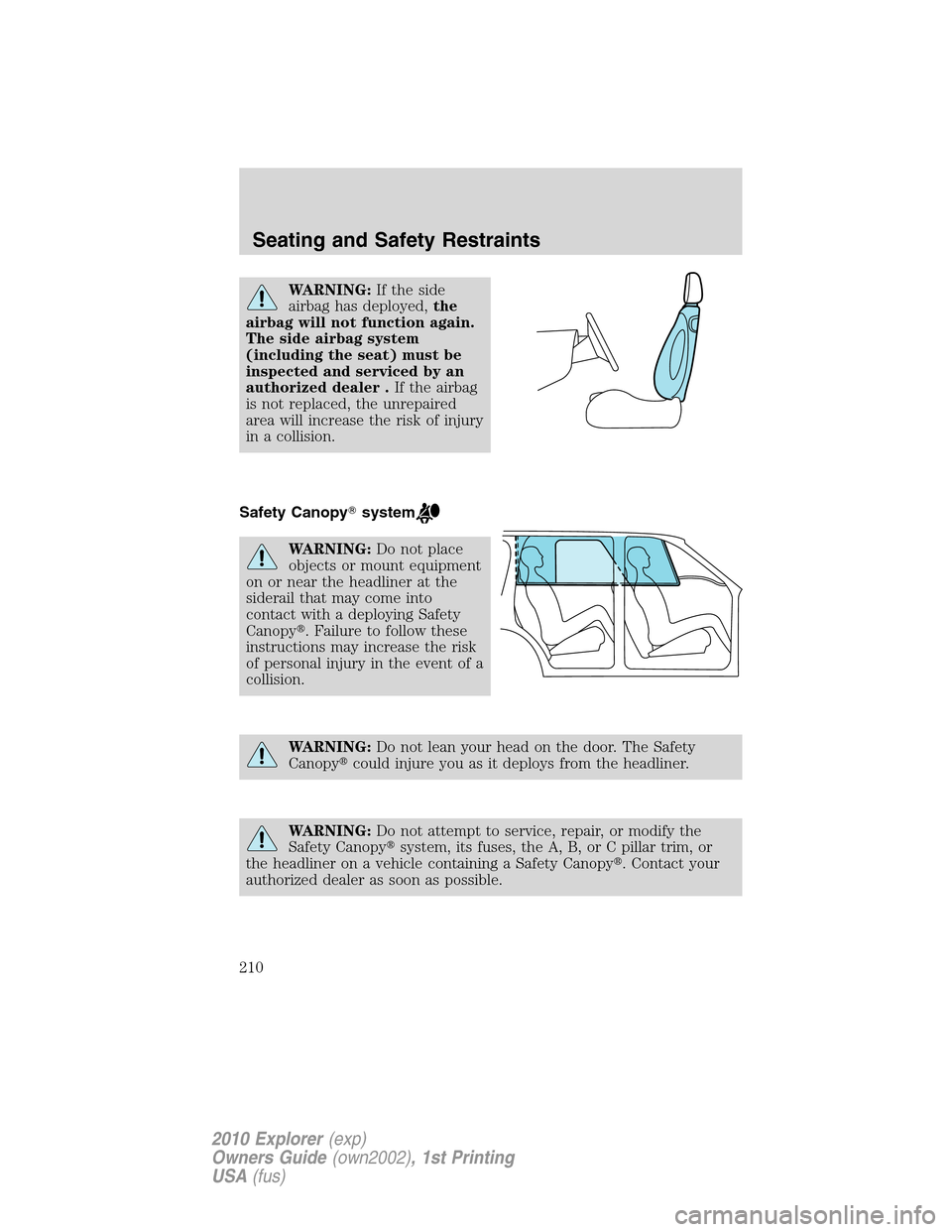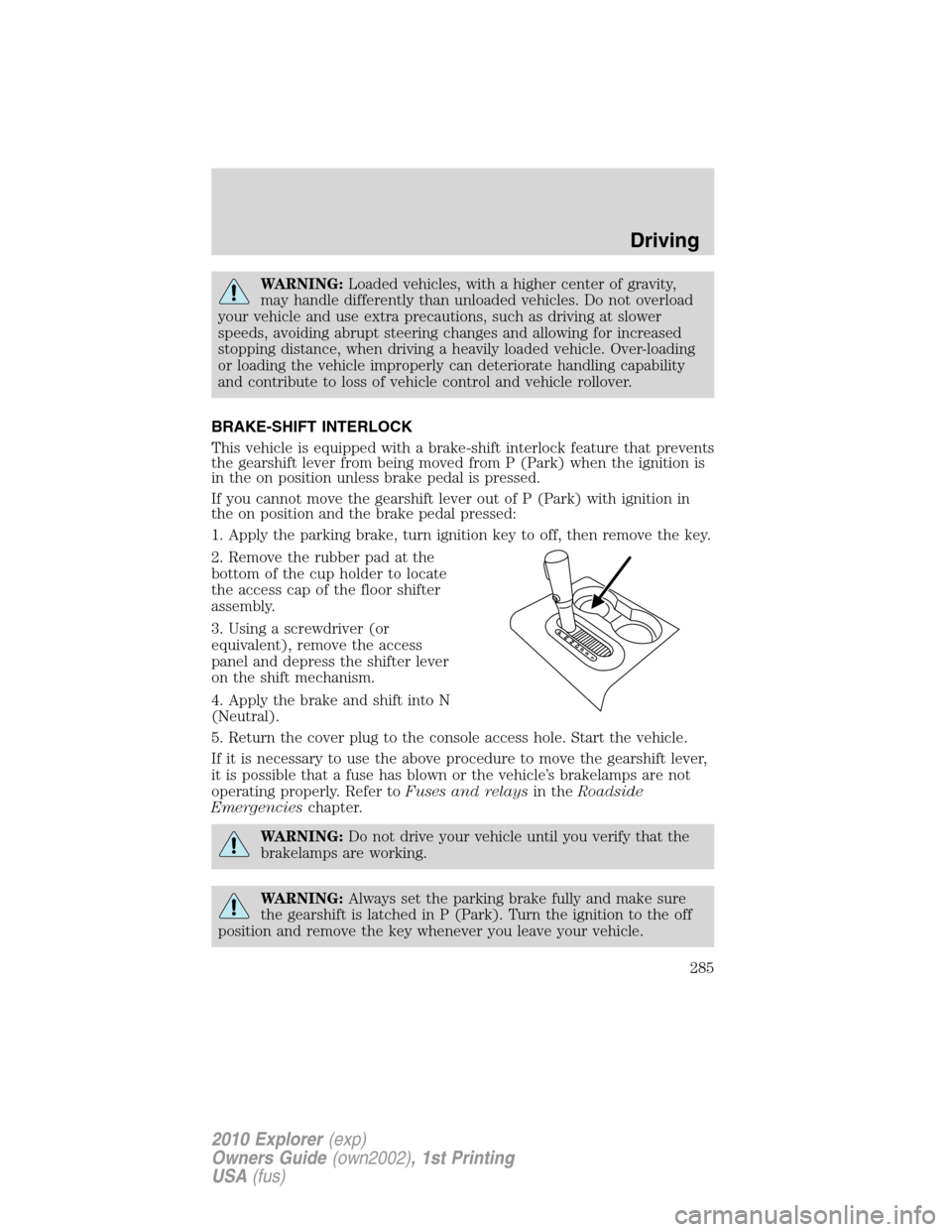Page 2 of 404
Locks and Security 150
Keys 150
Locks 150
Anti-theft system 156
Seating and Safety Restraints 166
Seating 166
Safety restraints 184
Airbags 199
Child restraints 214
Tires, Wheels and Loading 233
Tire information 235
Tire inflation 238
Tire Pressure Monitoring System (TPMS) 250
Vehicle loading 255
Trailer towing 263
Recreational towing 268
Driving 270
Starting 270
Brakes 275
AdvanceTrac�278
Transmission operation 286
Reverse sensing system 291
Roadside Emergencies 305
Getting roadside assistance 305
Hazard flasher control 306
Fuel pump shut-off switch 307
Fuses and relays 308
Changing tires 315
Wheel lug nut torque 324
Jump starting 325
Wrecker towing 331
Table of Contents
2
2010 Explorer(exp)
Owners Guide(own2002), 1st Printing
USA(fus)
Page 121 of 404

WARNING:Use only soft cups in the cupholder. Hard objects
can injure you in a collision.
Rear center console features (if equipped)
The rear center console incorporates the following features:
•Utility compartment
•Cupholders
•Flip forward armrest to provide a
flat load floor
AUXILIARY POWER POINTS (12VDC)
Power outlets are designed for accessory plugs only. Do not insert
any other object in the power outlet as this will damage the
outlet and blow the fuse. Do not hang any type of accessory or
accessory bracket from the plug. Improper use of the power
outlet can cause damage not covered by your warranty.
Auxiliary power points can be found in the following locations:
•On the front of the center console
•Inside the utility compartment
•On the rear of the console, accessible from the rear seats
Do not use the power point for operating the cigarette lighter element (if
equipped).
To prevent the fuse from being blown, do not use the power point(s)
over the vehicle capacity of 12 VDC/180W. If the power point or cigar
lighter socket is not working, a fuse may have blown. Refer toFuses and
relaysin theRoadside Emergencieschapter for information on
checking and replacing fuses.
Driver Controls
121
2010 Explorer(exp)
Owners Guide(own2002), 1st Printing
USA(fus)
Page 200 of 404

WARNING:Never place your arm over the airbag module as a
deploying airbag can result in serious arm fractures or other
injuries.
To properly position yourself away from the airbag:
•Move your seat to the rear as far as you can while still reaching the
pedals comfortably.
•Recline the seat slightly one or two degrees from the upright position.
WARNING:Do not put anything on or over the airbag module.
Placing objects on or over the airbag inflation area may cause
those objects to be propelled by the airbag into your face and torso
causing serious injury.
WARNING:Do not attempt to service, repair, or modify the
airbag supplemental restraint systems or its fuses. Contact your
authorized dealer as soon as possible.
WARNING:Modifications to the front end of the vehicle,
including frame, bumper, front end body structure and non-Ford
tow hooks may effect the performance of the airbag sensors increasing
the risk of injury. Do not modify the front end of the vehicle with
anything other than authorized Ford accessories for your vehicle.
WARNING:Additional equipment may affect the performance of
the airbag sensors increasing the risk of injury.
Seating and Safety Restraints
200
2010 Explorer(exp)
Owners Guide(own2002), 1st Printing
USA(fus)
Page 208 of 404

A difficulty with the system is indicated by one or more of the following:
•The readiness light will either
flash or stay lit.
•The readiness light will not
illuminate immediately after
ignition is turned on.
•A series of five beeps will be heard. The tone pattern will repeat
periodically until the problem and/or light are repaired.
If any of these things happen, even intermittently, contact your
authorized dealer as soon as possible. Unless serviced, the system may
not function properly in the event of a collision.
Seat-mounted side airbag system
WARNING:Do not place objects or mount equipment on or
near the airbag cover on the side of the seatbacks of the front
seats or in front seat areas that may come into contact with a
deploying airbag. Failure to follow these instructions may increase the
risk of personal injury in the event of a collision.
WARNING:Do not use accessory seat covers. The use of
accessory seat covers may prevent the deployment of the side
airbags and increase the risk of injury in an accident.
WARNING:Do not lean your head on the door. The side airbag
could injure you as it deploys from the side of the seatback.
WARNING:Do not attempt to service, repair, or modify the
airbag SRS, its fuses or the seat cover on a seat containing an
airbag. Contact your authorized dealer as soon as possible.
WARNING:All occupants of the vehicle should always wear
their safety belts even when an airbag SRS is provided.
How does the side airbag system work?
The design and development of the side airbag system included
recommended testing procedures that were developed by a group of
Seating and Safety Restraints
208
2010 Explorer(exp)
Owners Guide(own2002), 1st Printing
USA(fus)
Page 210 of 404

WARNING:If the side
airbag has deployed,the
airbag will not function again.
The side airbag system
(including the seat) must be
inspected and serviced by an
authorized dealer .If the airbag
is not replaced, the unrepaired
area will increase the risk of injury
in a collision.
Safety Canopy�system
WARNING:Do not place
objects or mount equipment
on or near the headliner at the
siderail that may come into
contact with a deploying Safety
Canopy�. Failure to follow these
instructions may increase the risk
of personal injury in the event of a
collision.
WARNING:Do not lean your head on the door. The Safety
Canopy�could injure you as it deploys from the headliner.
WARNING:Do not attempt to service, repair, or modify the
Safety Canopy�system, its fuses, the A, B, or C pillar trim, or
the headliner on a vehicle containing a Safety Canopy�. Contact your
authorized dealer as soon as possible.
Seating and Safety Restraints
210
2010 Explorer(exp)
Owners Guide(own2002), 1st Printing
USA(fus)
Page 285 of 404

WARNING:Loaded vehicles, with a higher center of gravity,
may handle differently than unloaded vehicles. Do not overload
your vehicle and use extra precautions, such as driving at slower
speeds, avoiding abrupt steering changes and allowing for increased
stopping distance, when driving a heavily loaded vehicle. Over-loading
or loading the vehicle improperly can deteriorate handling capability
and contribute to loss of vehicle control and vehicle rollover.
BRAKE-SHIFT INTERLOCK
This vehicle is equipped with a brake-shift interlock feature that prevents
the gearshift lever from being moved from P (Park) when the ignition is
in the on position unless brake pedal is pressed.
If you cannot move the gearshift lever out of P (Park) with ignition in
the on position and the brake pedal pressed:
1. Apply the parking brake, turn ignition key to off, then remove the key.
2. Remove the rubber pad at the
bottom of the cup holder to locate
the access cap of the floor shifter
assembly.
3. Using a screwdriver (or
equivalent), remove the access
panel and depress the shifter lever
on the shift mechanism.
4. Apply the brake and shift into N
(Neutral).
5. Return the cover plug to the console access hole. Start the vehicle.
If it is necessary to use the above procedure to move the gearshift lever,
it is possible that a fuse has blown or the vehicle’s brakelamps are not
operating properly. Refer toFuses and relaysin theRoadside
Emergencieschapter.
WARNING:Do not drive your vehicle until you verify that the
brakelamps are working.
WARNING:Always set the parking brake fully and make sure
the gearshift is latched in P (Park). Turn the ignition to the off
position and remove the key whenever you leave your vehicle.
Driving
285
2010 Explorer(exp)
Owners Guide(own2002), 1st Printing
USA(fus)
Page 308 of 404
FUSES AND RELAYS
Fuses
If electrical components in the
vehicle are not working, a fuse may
have blown. Blown fuses are
identified by a broken wire within
the fuse. Check the appropriate
fuses before replacing any electrical
components.
Note:Always replace a fuse with one that has the specified amperage
rating. Using a fuse with a higher amperage rating can cause severe wire
damage and could start a fire.
Standard fuse amperage rating and color
COLOR
Fuse
ratingMini fusesStandard
fusesMaxi fusesCartridge
maxi fuses
2A Grey Grey — —
3A Violet Violet — —
4A Pink Pink — —
5A Tan Tan — —
7.5A Brown Brown — —
10A Red Red — —
15A Blue Blue — —
20A Yellow Yellow Yellow Blue
25A Natural Natural — —
30A Green Green Green Pink
40A — — Orange Green
50A — — Red Red
60A — — Blue Yellow
70A — — Tan —
80A — — Natural —
15
Roadside Emergencies
308
2010 Explorer(exp)
Owners Guide(own2002), 1st Printing
USA(fus)
Page 309 of 404
Passenger compartment fuse panel
The fuse panel is located below the
instrument panel on the driver’s
side.
To remove a fuse use the fuse puller tool provided on the fuse panel box.
The fuses are coded as follows:
Fuse/Relay
LocationFuse Amp
RatingProtected Circuits
1 20A Moon roof, Adjustable pedals,
Memory seats, Lumbar motor
2 5A Microcontroller power
3 20A Radio, Navigation amplifier, GPS
module
4 10A On-board diagnostic (OBD II)
connector
C
B
1 4
3
2
18
7
6
51
2
1
1
1
0
91
6
1
5
1
4
1
32
0
1
9
1
8
1
72
4
2
3
2
2
2
12
8
2
7
2
6
2
5
Roadside Emergencies
309
2010 Explorer(exp)
Owners Guide(own2002), 1st Printing
USA(fus)